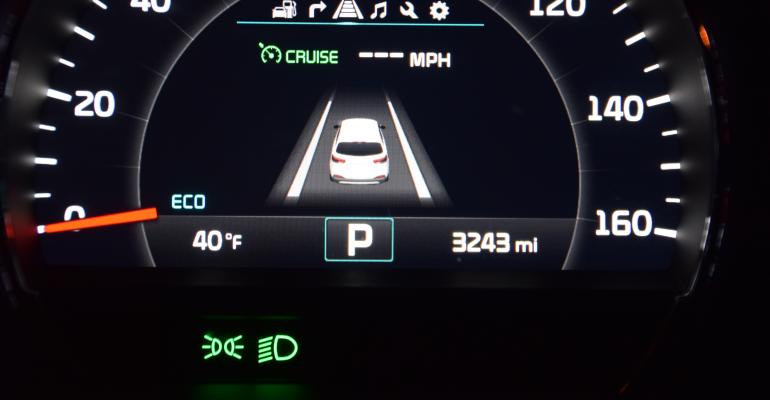TROY, MI – Advanced driver-assistance systems could prevent nearly 10,000 fatalities and save the U.S. $251 billion annually, but automakers, regulators and everyday Americans must get onboard now to speed up adoption of technologies that someday may lead to a zero-crash environment.
“There is not much we can do that will save our economy more money than this,” says Xavier Mosquet, leader-North America Automotive at Boston Consulting Group.
“It is not a futuristic discussion,” adds Mosquet, co-author of a newly released study on ADAS and its potential to pave the way for autonomous driving. “It is an opportunity we can take today.”
But the uptake of ADAS has been slow, especially in the U.S. For example, adaptive cruise control, a foundation of forward-collision alert and automatic emergency braking, appears on just 7.5% of ’15 model vehicles. The penetration of lane-departure warning technology has reached 16.4% and blindspot detection 19.7%.
Blame system costs, which like federally mandated fuel-saving technologies can handcuff the ability of automakers to roll ADAS out to more vehicles. And while federal regulators have begun singing the praises of ADAS, it is not a factor in NCAP crash-test ratings. Most consumers do not see the benefit of paying extra for the technology, either, and remain skeptical of its safety and convenience benefits because awareness is low.
“That is one thing we have to solve,” says Steve Handshuh, president and CEO of the Motor & Equipment Manufacturers Assn., which commissioned the BCG study. “For most consumers, this is not something they would pay for.”
The BCG study estimates a full ADAS package would add $8,240 to the cost of the average light vehicle. That’s too much for the average car buyer to swallow and a sure-fire bullet to profitability if automakers were to slash costs – at least right now, the study finds.
“As volumes grow, prices go down,” Mosquet says in a briefing here for journalists. “If there is no adoption, prices remain high. It is a chicken-and-the-egg sort of thing.”
That’s unfortunate, he says, because the technology could offer a cumulative safety return of 58% in 15 years and 98% in 20 years. And as the building blocks for autonomous driving, which BCG sees in 2025, the investment in such technologies could return 439% in 20 years.
“We’ll get back four times the investment,” Mosquet offers.
But traditional market dynamics are not enough to unlock the potential of ADAS, the consultant adds. Automakers can help improve adoption rates by unbundling the technologies from expensive option packages, while the federal government could factor them into 5-star crash-test ratings and perhaps provide incentives similar to electric- and plug-in electric-vehicle tax breaks for consumers to buy them.
Insurance companies also could ante up by offering discounts on premiums if ADAS technologies appear on a vehicle, and a consumer-education program in the spirit of the “Click-It-or-Ticket” campaign that starts in driver-training programs would be helpful, too. Dealers could join in the educational piece as Americans shop for a new car.
“Most consumers, until they have tried it, do not know the benefit,” Mosquet says. “We have to educate people.”
But the ball is rolling. In early September, 10 automakers committed to making automatic emergency braking standard equipment on new vehicles, although a timeframe has not been determined. Some insurance companies are giving owners a break on their premiums as the technology rolls out in vehicles such as the safety-rich ’15 Volvo XC90.
A deeper commitment will be needed for the U.S. to keep pace with Europe and Japan, leaders in ADAS technology. In Europe, where ADAS in the region benefits from a build-to-order retail model and safety ratings incorporating the technologies, the penetration of forward-collision warning is twice that of the U.S.
China significantly trails Europe and Japan in ADAS adotpion, but has pledged to be on par with them by 2018.
“In the U.S., the motivation is high,” Mosquet says. “The question is how we will move the ball beyond that.”
The traditional trickle-down of advanced technology from luxury brands to volume offerings will take too much time and fail to accelerate ADAS beyond the current 2%-5% annually to realize its promise, Handshuh warns.
“Doing nothing beyond what we have done to this point, that’s the rate we’re going to continue at,” he says. Without breaking the tradition paradigm, he adds, it will be up to 25 years before the U.S. fleet is affected by ADAS.
Ann Wilson, senior vice president-Government Affairs at MEMA, says the industry lobbyist plans to make ADAS a key element of a long-term transportation bill under scrutiny in Washington. MEMA also will throw its weight behind a Senate provision directing NHTSA, the nation’s top safety regulator, to factor ADAS into crash-test ratings.
Wilson says MEMA will additionally work within the Transatlantic Trade and Investment Partnership to strengthen harmonized safety standards, focusing on automatic emergency braking and adaptive front lighting, as well as push for incentives for ADAS in CAFE regulations.





